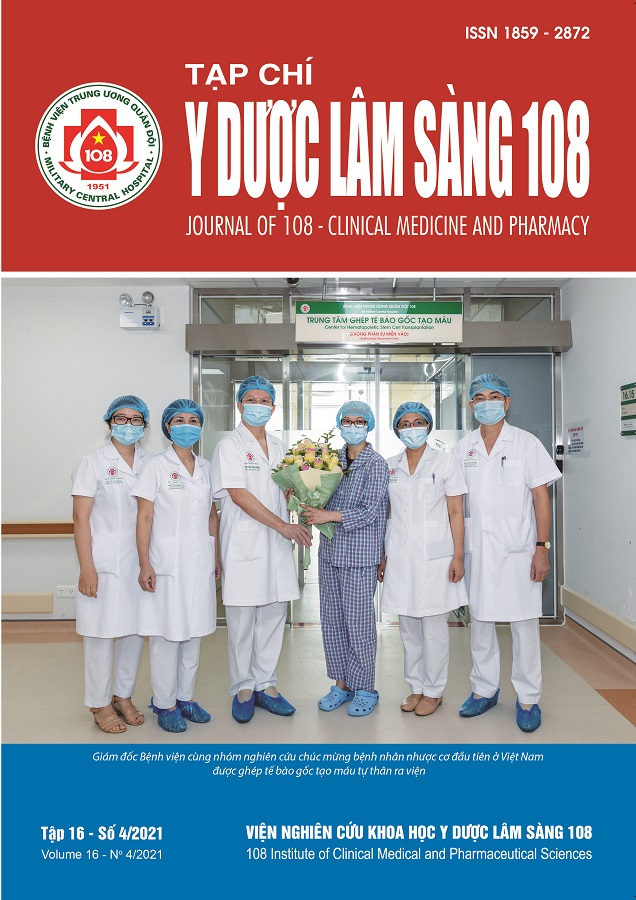Assessment of left ventricular strain and twist by 3-dimentional speckle tracking echocardiography in patients with chronic heart failure
Main Article Content
Keywords
Abstract
Objective: To evaluate echocardiographic torsional and strain parameters of left ventricle by 3D speckle tracking echocardiography in patients with chronic heart failure. Subject and method: A prospective, case-control, cross-sectional study which was conducted on 110 patients with chronic heart failure and 50 healthy people hospitalized at the Department of Cardiology, 108 Military Central Hospital from January 2018 to October 2020. Result: The mean age of patients with heart failure was 65.82 ± 11.77 years old, men were 66.36%, the average age of the control group was 65.16 ± 10.24, men accounted for 68%. All LV strain and torsional indices in the heart failure patients were lower than that of the control group (p<0.05): Global longitudinal strain (GLS), twist in the heart failure group was -11.01 ± 3.82s-1 and 7.94 ± 4.28 degrees; in the control group were -19.92 ± 2.87s-1 and 16.83 ± 9.87 degrees; In the heart failure group, EF ≥ 50% was -14.25s-1 ± 4.35 and 10.96 ± 4.74 degrees. LV strain and torsion decreased according to EF: GLS, twist in EF < 40% group was -8.79 ± 2.5s-1 and 5.89 ± 2.79 degrees respectively, in EF group 40 - 49% was -11.47 ± 2.4s-1 and 8.34 ± 4.05 degree, in the EF < 40% group it was -17.79 ± 4.44s-1 and 10.96 ± 4.74 degrees. In HF patients with reduced EF, GLS was decreased in 100% patients, twist reduced in 98.8% patients, in reverse, patients with preserved EF, this rate was only 73.3% and 53.3%. Conclusion: Left ventricular global longitudinal strain (GLS), radial strain (GRS), circumferential strain (GCS), area strain (GAS) reduced in patients with chronic heart failure compared with controls. These parameters changed in HF patients with preserved EF earlier then EF. GLS and GRS are more frequently seen in HF patients.
Article Details
References
2. Solomon S et al (2005) Candesartan in Heart Failure Reduction in Mortality I. Influence of ejection fraction on cardiovascular outcomes in a broad spectrum of heart failure patients. Circulation 112: 3738-3744.
3. Solomon S (2005) Candesartan in Heart Failure Reduction in Mortality (CHARM) Investigators. Influence of ejection fraction on cardiovascular outcomes in a broad spectrum of heart failure patients. Circulation 112: 3738-3744.
4. Klaeboe LG and Edvardsen T (2019) Echocardiographic assessment of left ventricular systolic function. Journal of echocardiography 17(1): 10-16.
5. Muraru D et al (2018) Three-dimensional speckle-tracking echocardiography: Benefits and limitations of integrating myocardial mechanics with three-dimensional imaging. Cardiovascular diagnosis and therapy 8(1): 101.
6. Ponikowski P et al (2016) 2016 ESC Guidelines for the diagnosis and treatment of acute and chronic heart failure: The Task Force for the diagnosis and treatment of acute and chronic heart failure of the European Society of Cardiology (ESC)Developed with the special contribution of the Heart Failure Association (HFA) of the ESC. European Heart Journal 37(27): 2129-2200.
7. Altman M et al (2014) Assessment of left ventricular systolic function by deformation imaging derived from speckle tracking: A comparison between 2D and 3D echo modalities. European Heart Journal - Cardiovascular Imaging 15(3): 316-323.
8. Sengupta PP et al (2008) Twist mechanics of the left ventricle: Principles and application. JACC: Cardiovascular Imaging 1(3): 366-376.
9. Kraigher-Krainer E et al (2014) Impaired systolic function by strain imaging in heart failure with preserved ejection fraction. Journal of the American College of Cardiology 63(5): 447-456.
10. Luo XX et al (2014) What can three-dimensional speckle-tracking echocardiography contribute to evaluate global left ventricular systolic performance in patients with heart failure? International journal of cardiology 172(1): 132-137.
 ISSN: 1859 - 2872
ISSN: 1859 - 2872
